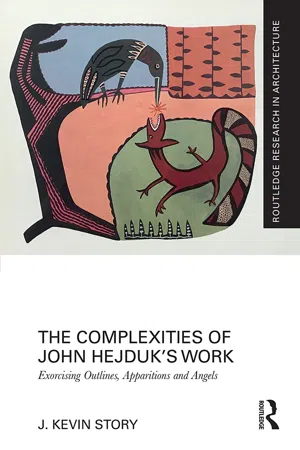
The Complexities of John Hejduk's Work
Exorcising Outlines, Apparitions and Angels
- 240 pages
- English
- ePUB (mobile friendly)
- Available on iOS & Android
About this book
This book traces the development of John Hejduk's architectural career, using the idea of "exorcism" to uncover his thought process when examining architectural designs. His work encouraged profound questioning on what, why and how we build, which allowed for more open discourse and enhance the phenomenology found in architectural experiences.
Three distinct eras in his architectural career are applied to analogies of outlines, apparitions and angels throughout the book across seven chapters. Using these thematic examples, the author investigates the progression of thought and depth inside the architect's imagination by studying key projects such as the Texas houses, Wall House, Architectural Masques and his final works.
Featuring comments by Gloria Fiorentino Hejduk, Stanley Tigerman, Steven Holl, Zaha Hadid, Charles Jencks, Phyllis Lambert, Juhani Pallasmaa, Toshiko Mori and others, this book brings to life the intricacies in the mind of John Hejduk, and would be beneficial for those interested in architecture and design in the 20th century.
Frequently asked questions
- Essential is ideal for learners and professionals who enjoy exploring a wide range of subjects. Access the Essential Library with 800,000+ trusted titles and best-sellers across business, personal growth, and the humanities. Includes unlimited reading time and Standard Read Aloud voice.
- Complete: Perfect for advanced learners and researchers needing full, unrestricted access. Unlock 1.4M+ books across hundreds of subjects, including academic and specialized titles. The Complete Plan also includes advanced features like Premium Read Aloud and Research Assistant.
Please note we cannot support devices running on iOS 13 and Android 7 or earlier. Learn more about using the app.
Information
1 Formations of John Hejduk’s pedagogy
Exorcising outlines, Part 1
Early artistic influences
Robert Gwathmey

George Kratina
Henrietta Schutz
Table of contents
- Cover
- Half Title
- Series Page
- Title Page
- Copyright Page
- Table of Contents
- List of illustrations
- Foreword
- Acknowledgements
- Introduction
- 1. Formations of John Hejduk’s pedagogy: exorcising outlines, Part 1
- 2. Pedagogy of the Texas Houses: exorcising outlines, Part 2
- 3. Pedagogy of the Wall House: exorcising apparitions, Part 1
- 4. Pedagogy of the Architectural Masque: exorcising apparitions, Part 2
- 5. Pedagogy of the Last Works: exorcising angels
- 6. Pedagogy of the Cigar Box: experiencing the otherness of John Hejduk
- 7. A serendipitous life: the end of the beginning
- Epilogue: The otherness of John Hejduk: a collection of thought
- Bibliography
- Index